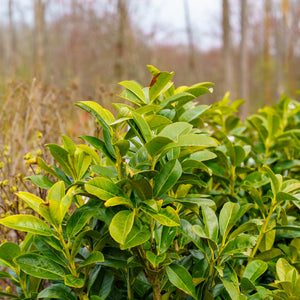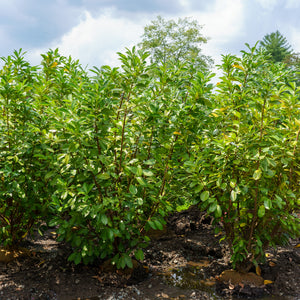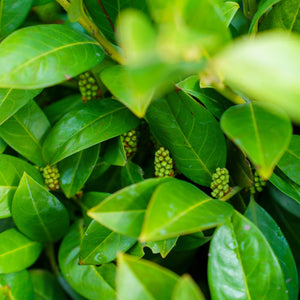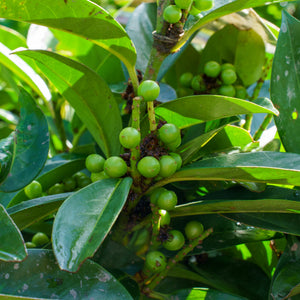The Cherry Laurel Guide
Cherry Laurel (Prunus laurocerasus) is a fast-growing, evergreen shrub prized for its glossy foliage, dense habit, and versatility in landscape design. Native to regions surrounding the Black Sea, this member of the Rosaceae family is widely used for privacy hedging, foundation plantings, and focal points due to its year-round greenery and adaptability. Cherry Laurel is valued for its ability to provide structure, screen views, and thrive in a variety of settings.
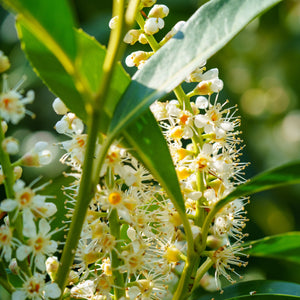
About
Cherry Laurel is a broadleaf evergreen shrub or small tree that produces fragrant white flower spikes in spring, followed by small black fruits. Its thick, leathery leaves are deep green and lustrous, making it a striking background plant or hedge. Depending on the cultivar, Cherry Laurel can range from compact, rounded forms to upright, fast-growing screens.
Popular cultivars include Prunus laurocerasus 'Otto Luyken', a dwarf variety with a low, spreading habit ideal for foundation plantings and mass plantings. Prunus laurocerasus 'Schipkaensis' (commonly called Schip Laurel) is narrow and upright, excellent for privacy hedges. For a more refined look, Prunus laurocerasus 'Chestnut Hill' provides compact growth with excellent leaf retention and disease resistance.
Cherry Laurel is often used to define spaces in the landscape, soften the edges of buildings, or serve as a year-round focal point. It is particularly useful in shaded or partially shaded areas where other screening plants may struggle.
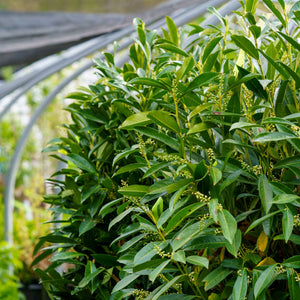
PLANTING
Cherry Laurel is best planted with consideration for its mature size and site preferences. With proper placement and soil preparation, it will establish quickly and grow vigorously.
- USDA Hardiness Zones: 6–9. Some cultivars, such as 'Otto Luyken', are more cold-hardy, while others may prefer milder climates.
- Soil: Prefers fertile, well-drained soil with moderate moisture. Tolerates a range of soil types but may struggle in heavy clay or poorly drained conditions.
- Sunlight: Performs best in full sun to partial shade. Tolerates shade better than many other broadleaf evergreens.
- Watering: Water regularly during establishment. Once established, Cherry Laurel is drought-tolerant but will perform best with consistent moisture.
- Spacing: For hedges, space plants 3 to 6 feet apart depending on the cultivar. Upright varieties like 'Schipkaensis' can be spaced more closely; spreading types like 'Otto Luyken' need room to spread horizontally.
- Planting Time: Plant in early spring or fall to give roots time to establish in cool, moist conditions.
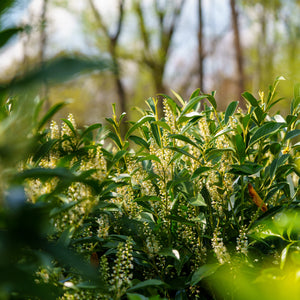
CARE
With proper maintenance, Cherry Laurel will reward you with lush, year-round foliage and seasonal blooms.
- Watering: Keep soil evenly moist during the first year. Mature plants tolerate dry spells but benefit from deep watering during extended droughts.
- Fertilizing: Apply a balanced slow-release fertilizer in early spring to support vigorous growth.
- Pruning: Prune after flowering or in late winter to shape and control size. Cherry Laurel can tolerate hard pruning, making it easy to rejuvenate overgrown plants or maintain formal hedges.
- Mulching: Mulch annually to maintain soil moisture and suppress weeds.
- Pests & Diseases: Generally resistant to deer and pests but may be susceptible to shot hole fungus, leaf spot, or powdery mildew in humid or wet conditions. Provide good airflow and avoid overhead watering.
Caution: Cherry Laurel contains cyanogenic compounds and is toxic to pets and humans if ingested. Avoid planting in areas frequented by children or animals likely to chew foliage.
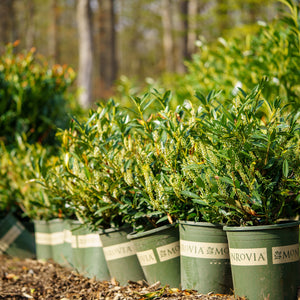
HOW TO USE
Cherry Laurel offers structure and visual weight in the garden, making it a staple in both formal and naturalistic designs. It can serve as a reliable evergreen backdrop or a bold focal point.
- Hedges & Screens: Upright cultivars like Prunus laurocerasus 'Schipkaensis' or 'Caucasica' form dense, fast-growing barriers ideal for noise and privacy screening.
- Foundation Plantings: Compact varieties like 'Otto Luyken' are well-suited for low-maintenance foundation borders.
- Mass Plantings: Use spreading forms such as 'Chestnut Hill' to cover large areas with consistent evergreen texture.
- Focal Points: A mature Cherry Laurel, particularly a tree-form specimen, can anchor a garden bed or provide structure at the end of a pathway.
- Mixed Borders: Combine with shade-loving perennials such as Helleborus, Ferns, or Heuchera to create layered interest in woodland-style plantings.
With year-round greenery and flexible form, Cherry Laurel can be shaped to suit nearly any landscape role.
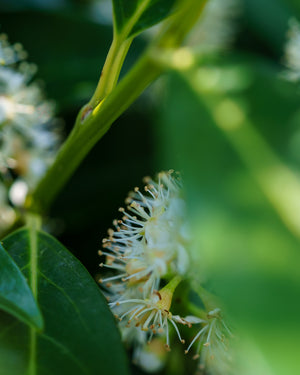
Common Questions
- How fast does Cherry Laurel grow? Growth varies by cultivar, but most Cherry Laurels grow 1 to 2 feet per year when established.
- When should you prune Cherry Laurel? Prune in late winter or after flowering in early summer to maintain shape and remove any dead or damaged wood.
- Is Cherry Laurel poisonous to dogs or cats? Yes, all parts of the plant are toxic if ingested due to cyanogenic glycosides.
- Do deer eat Cherry Laurel? Cherry Laurel is considered deer-resistant, though young plants may be occasionally browsed.
- Can you eat Cherry Laurel berries? No, the berries are toxic and should not be consumed by humans or pets.
- How tall do Cherry Laurels grow? Size depends on the variety. Dwarf forms like 'Otto Luyken' stay around 3 feet tall, while upright varieties like 'Schipkaensis' can reach 10 to 15 feet or more.
- Is Cherry Laurel invasive? In some regions, Cherry Laurel can naturalize aggressively. Check local guidelines before planting.
- What is Cherry Laurel used for? It's commonly used for evergreen hedges, foundation plantings, screens, and focal points in both residential and commercial landscapes.
Conclusion
Cherry Laurel is a versatile and attractive evergreen shrub that brings bold texture, structure, and color to a variety of landscape settings. Whether you’re building a living fence with Prunus laurocerasus 'Schipkaensis' or adding a tidy foundation plant with 'Otto Luyken', Cherry Laurel provides reliable performance with relatively low maintenance. Its year-round interest, adaptability to sun and shade, and ability to act as a privacy screen or focal point make it a staple choice for both professionals and home gardeners.
The Cherry Laurel Collection
Sold Out
Sold Out

